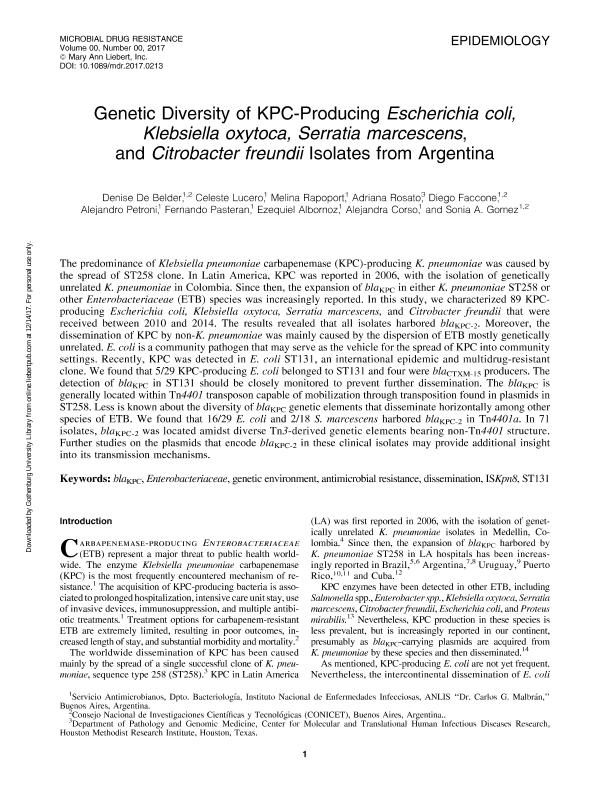Artículo
Genetic Diversity of KPC-Producing Escherichia coli, Klebsiella oxytoca, Serratia marcescens , and Citrobacter freundii Isolates from Argentina
de Belder, Denise Gisele ; Lucero, Celeste; Rapoport, Melina; Rosato, Adriana; Faccone, Diego Francisco
; Lucero, Celeste; Rapoport, Melina; Rosato, Adriana; Faccone, Diego Francisco ; Petroni, Alejandro; Pasteran, Fernando; Albornoz, Ezequiel Pablo
; Petroni, Alejandro; Pasteran, Fernando; Albornoz, Ezequiel Pablo ; Corso, Alejandra; Gómez, Sonia Alejandra
; Corso, Alejandra; Gómez, Sonia Alejandra
 ; Lucero, Celeste; Rapoport, Melina; Rosato, Adriana; Faccone, Diego Francisco
; Lucero, Celeste; Rapoport, Melina; Rosato, Adriana; Faccone, Diego Francisco ; Petroni, Alejandro; Pasteran, Fernando; Albornoz, Ezequiel Pablo
; Petroni, Alejandro; Pasteran, Fernando; Albornoz, Ezequiel Pablo ; Corso, Alejandra; Gómez, Sonia Alejandra
; Corso, Alejandra; Gómez, Sonia Alejandra
Fecha de publicación:
12/2017
Editorial:
Mary Ann Liebert
Revista:
Microbial Drug Resistance: Mechanisms Epidemiology and Disease
ISSN:
1076-6294
Idioma:
Inglés
Tipo de recurso:
Artículo publicado
Clasificación temática:
Resumen
The predominance of Klebsiella pneumoniae carbapenemase (KPC)-producing K. pneumoniae was caused by the spread of ST258 clone. In Latin America, KPC was reported in 2006, with the isolation of genetically unrelated K. pneumoniae in Colombia. Since then, the expansion of blaKPC in either K. pneumoniae ST258 or other Enterobacteriaceae (ETB) species was increasingly reported. In this study, we characterized 89 KPC producing Escherichia coli, Klebsiella oxytoca, Serratia marcescens, and Citrobacter freundii that were received between 2010 and 2014. The results revealed that all isolates harbored blaKPC-2. Moreover, the dissemination of KPC by non-K. pneumoniae was mainly caused by the dispersion of ETB mostly genetically unrelated. E. coli is a community pathogen that may serve as the vehicle for the spread of KPC into community settings. Recently, KPC was detected in E. coli ST131, an international epidemic and multidrug-resistant clone. We found that 5/29 KPC-producing E. coli belonged to ST131 and four were blaCTXM-15 producers. The detection of blaKPC in ST131 should be closely monitored to prevent further dissemination. The blaKPC isgenerally located within Tn4401 transposon capable of mobilization through transposition found in plasmids in ST258. Less is known about the diversity of blaKPC genetic elements that disseminate horizontally among other species of ETB. We found that 16/29 E. coli and 2/18 S. marcescens harbored blaKPC-2 in Tn4401a. In 71 isolates, blaKPC-2 was located amidst diverse Tn3-derived genetic elements bearing non-Tn4401 structure. Further studies on the plasmids that encode blaKPC-2 in these clinical isolates may provide additional insight into its transmission mechanisms.
Palabras clave:
Blakpc
,
Enterobacteriaceae
,
Genetic Environment
,
Antimicrobial Resistance
Archivos asociados
Licencia
Identificadores
Colecciones
Articulos(SEDE CENTRAL)
Articulos de SEDE CENTRAL
Articulos de SEDE CENTRAL
Citación
de Belder, Denise Gisele; Lucero, Celeste; Rapoport, Melina; Rosato, Adriana; Faccone, Diego Francisco; et al.; Genetic Diversity of KPC-Producing Escherichia coli, Klebsiella oxytoca, Serratia marcescens , and Citrobacter freundii Isolates from Argentina; Mary Ann Liebert; Microbial Drug Resistance: Mechanisms Epidemiology and Disease; 12-2017; 1-8
Compartir
Altmétricas



